Слайд 1Penza State University Medical Institute
Helen Flanders Dunbar (1902 – 1950)
important early figure in U.S.
Doctor: Gavrilova Tatiana Student: Ahmed Hassan
Alamoudi Number of Group: 19лс2а
2020
Слайд 2Despite Dunbar's central role in the American psychosomatic movement, few
successors seem to have grasped the nature and context of
her work. This is partially because most histories of psychosomatic theory and research overlook the hotistic, organismic point of view shared by Dunbar and other psychoanalysts of the psychobiologic persuasion. The medical-philosophical context of Dunbar's work is here reviewed.
Throughout some 40 years of psychosomatic research, "Flanders Dunbar" has been a difficult name with which to contend. I say "name" because few seem to have known her in any other way, despite her central role within the American psychosomatic movement. In addition to Emotions and Bodily Changes, her survey of the literature which many consider to have launched the movement, Dunbar also wrote Psychosomatic Diagnosis, the field's first handbook, and Mind and Body: Psychosomatic Medicine, the field's first best seller. She also founded the American Psychosomatic Society and its journal, Psychosomatic Medicine, as welt as organized, in 1934- 1938, the first large-scale psychosomatic research program, involving the holistic evaluation of over 1,600 serial admissions to Columbia-Presbyterian Hospital in New York. Yet, despite this central role within the American psychosomatic movement, Dunbar was to many just a name--specifically, a name with which to contend.
During her rapid rise to eminence from 1930 to 1939, Dunbar created several successive spheres of influence, first at Columbia University and the
New York Academy of Medicine, then at the National Research Council and various large foundations, in the process providing the basis for a consolidated psychosomatic movement. But as she became famous, she also alienated many, on personal, political, and theoretical grounds. Many colleagues, especially males, seem to have felt threatened by her combination of coyness, elusiveness, and strength. Furthermore, her research, as many conservative physicians noted, could be used to argue for a more preventive, socialized medicine. On the
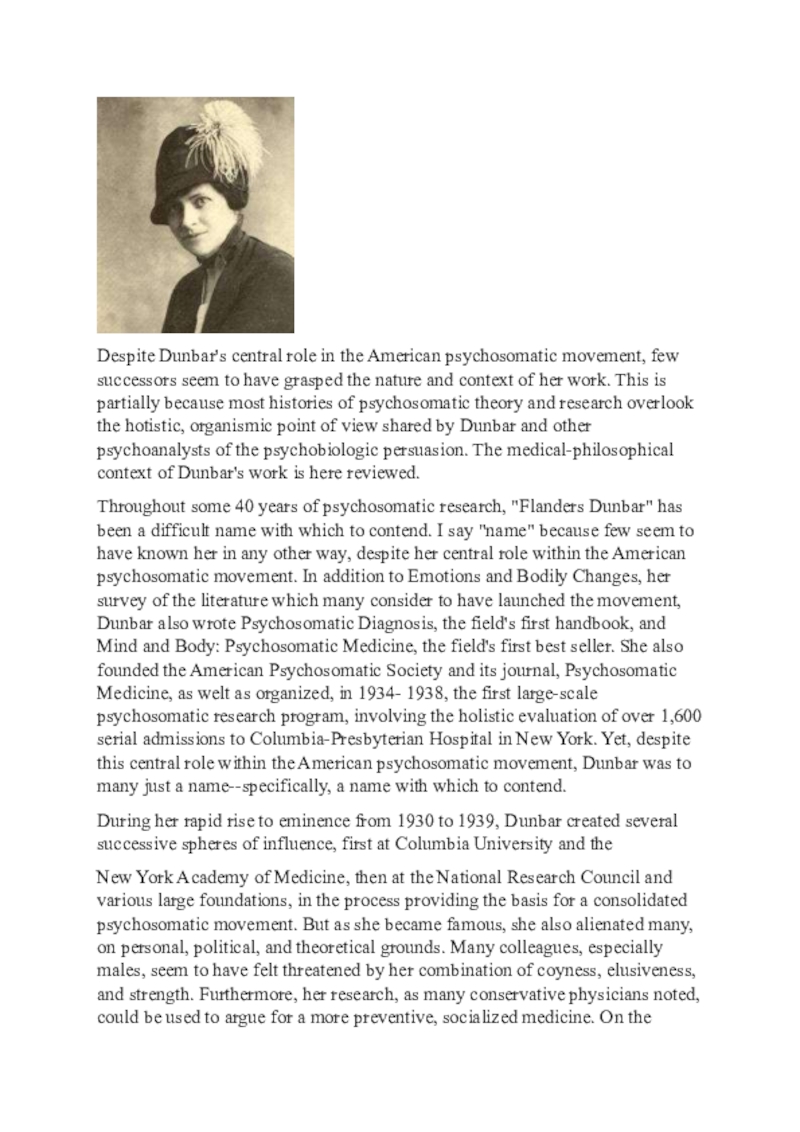
Слайд 3theoretical side, where this study will focus, as early as
1934 her work was seen in marked contrast to most
of the research being pursued by either psychoanalysts or psychophysiologists. In fact, the contrast was so marked that few of her colleagues or successors seem able to have grasped the nature of her research interests. Thus, after her rapid rise was followed by an equally rapid fall, in 1947 Dunbar withdrew as a vastly misunderstood woman, out of step with her time, while her ever-present name remained.
Who was Dunbar? This question even her closest friends asked and could not answer. No one knew. One of her colleagues over a period of two decades assured me that he never knew Dunbar as a person but only as a persona, as a mask growing ever-more impenetrable over the years.
Another close associate admitted that "after more than a generation of reflection" Dunbar still remained to him "basically an enigma. ''1° In addition, while some colleagues have recalled, without being able to account for it, the "sense of mission" with which she inspired them, others have recalled little but enmity toward her, for reasons equally obscure.
Despite the difficulties thus involved in understanding either Dunbar or her work---and I believe the two understandings must go hand-in hand---critics have rarely, until recently, 11-1a hesitated to voice simplistic repudiations. 14 For example, one review 1~ summed up her work with a single comment, "Subsequent... investigations have failed to support this.., position." Virtually every young psychosomatic investigator thus "knows" that Dunbar's theories and findings were "wrong." Part of the problem, however, might lie in the fact that "wrong" was defined about
35-40 years ago by those whose own theories have since been held in question? With all her books now again in print, and with a new generation of investigators in the laboratory and at the bedside, relatively untouched by the old personal, political, and theoretical squabbles, it may be time to take a fresh look at Dunbar's writings and their context---mspecially since
Dunbar must rank among the century's most cited yet unread medical authors.
It is easy enough to deduce Dunbar's conceptual context, which I shall soon consider in more detail. She shared the holistic, organismic viewpoint held by many philosophers, psychologists, and physicians during the period from about 1906 to 1936, an era when phrases such as "the organism as a whole," "the organism in its environment," and "mind-body unity" were used with a special degree of sincerity. But histories taking into account this hotistic, organismic approach to psychosomatic medicine simply do not exist--unless one wishes to
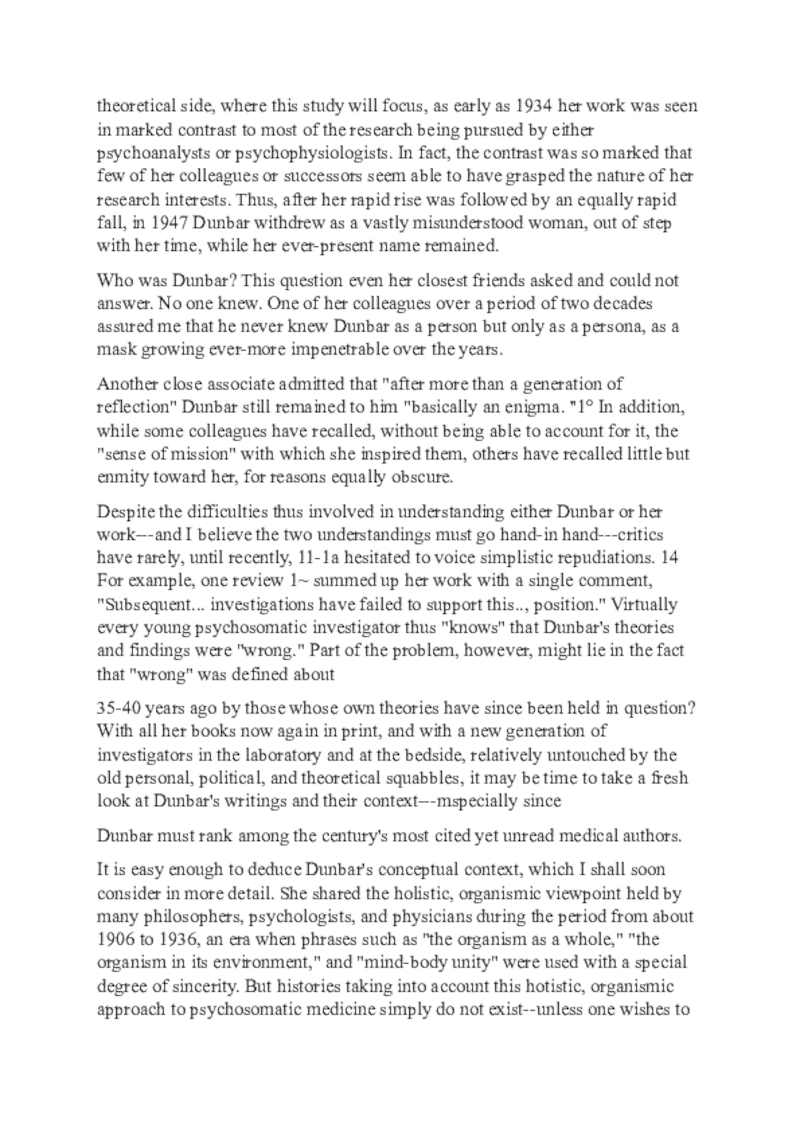
Слайд 4refer to passages in Dunbar's own writings. Most sketches of
the history of psychosomatic theory and research confine their attention
to psychoanalytic and psychophysiologic contributions, frequently introducing the parallel and somewhat specious distinction between "specificity theorists" (usually analysts) and "nonspecificity theorists" (usually physiologists), with "specificity" referring to the notion that specific causes lead to specific diseases. To make matters worse, many of these same accounts also distinguish two types of specificity theory, i.e., that espoused by the psychoanalyst Franz Alexander (1891-1964), asserting "specificity of [unconscious psychological] conflict" as the determinant of various psychosomatic disorders, and that attributed to Dunbar, supposedly focusing on "specificity of personality." It is rather difficult to derive a specificity theory from Dunbar's writings, and this fact alone prompts one to wonder whether a procrustean bed or two has slipped into the history of this field. Was specificity the only issue? Was psychosomatic medicine merely a matter of psychoanalysis and psychophysiology? One becomes even more puzzled upon discovering that whereas a number of physiologically oriented workers have criticized Dunbar's studies "because she was an analyst," many analytically inclined researchers have brushed her work aside "because she did not use psychoanalysis." Obviously something is wrong. Could it be that there are more than two conceptual threads to the history of psychosomatic medicine? Could it be that Dunbar, though an analyst, practiced the "wrong" kind of psychoanalysis?
The comments of two "elder statesmen" in the field suggest a way out of this dilemma. Looking to the past, Stanley Cobb once observed that psychosomatic medicine "was conceived by the coming together of three fertile schools of thought,
Psychoanalysis
The physiology of the emotions
Psychobiology."
Looking to the future, Eric Wittkower has suggested three alternatives that psychosomatic medicine might become,
A narrow psychiatric specialty with a psychoanalytic orientation,
A field of psychophysiologic research generally excluding the clinician, or
"A comprehensive holistic approach to the problems of medicine."
It is not by coincidence that Wittkower's three options parallel Cobb's three schools. Indeed, psychobiology, the holistic approach to medicine, represents
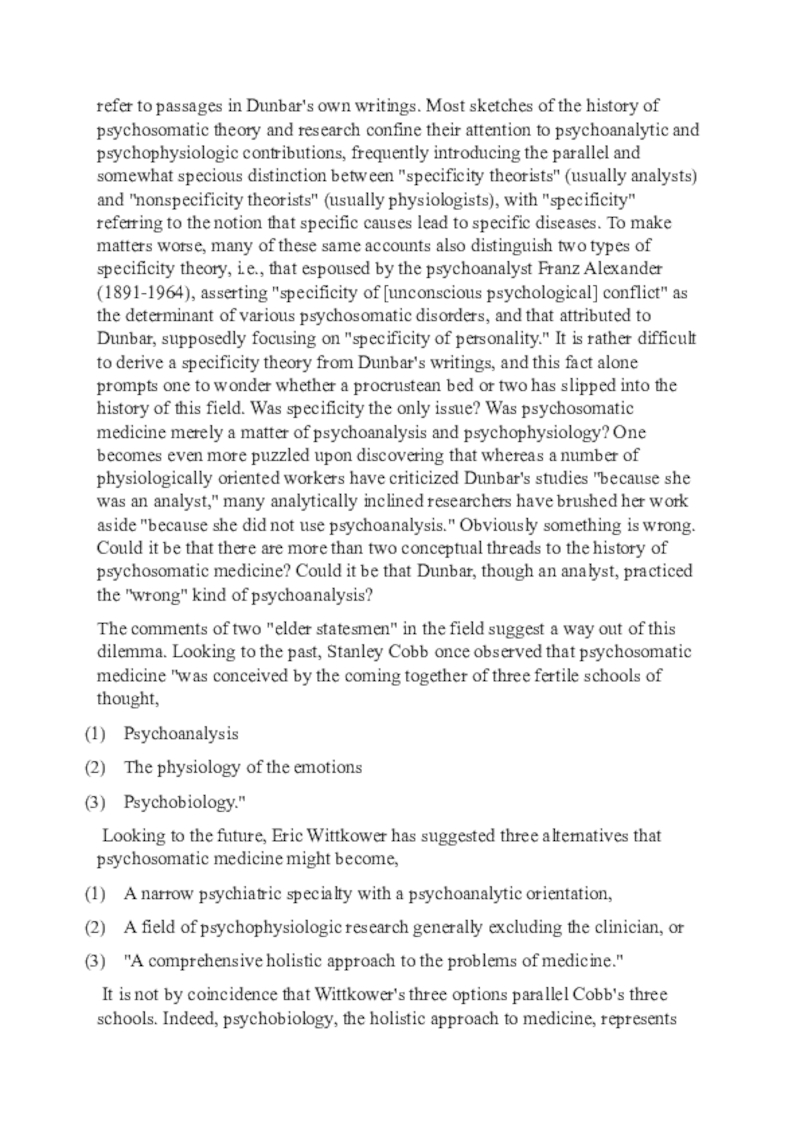
Слайд 5the conceptual thread missing in most histories of psychosomatic theory.
Dunbar, one soon discovers, was indeed an analyst, but a
psychoanalyst of the holistic, psychobiologic persuasion. That there were two forms of psychoanalysis in the United States during the 1930s is an easily documented but little appreciated fact. In brief, though an indigenous "American" form of psychoanalysis had been developing since about 1906 under the auspices of Adolf Meyer (1866- 1950), William Alanson White (1870-1937), Smith Ely Jelliffe (1866-1945), Edward J. Kempf (1885-1971 ), and others, between 1931 and 1933 a "new orthodoxy" was introduced through the establishment of three major psychoanalytic institutes, in New York, Chicago, and Boston, centered around three prominent Berlin-trained psychoanalysts, namely Sfindor Rado (1890-1971), Franz Alexander, and Hanns Sachs (1887-1947). The two forms of psychoanalysis, the German and the American, were quite different in their philosophical orientation during the 1930s. The German analysts, especially Alexander, never tired of referring to their "dynamic" stance, evidenced by theories of "psychogenesis" and "emotional vectors." The Americans, while adhering to a dynamic, adaptational, evolutionary point of view, preferred to focus less on psychical forces and more on the psychobiologic organism--the "organism as a whole," the "organism in its environment," the organism as a means of transforming psychical energy. Since the Berlin-trained directors of the American institutes managed to co-opt the term "psychoanalysis," especially after the influx of German analysts in 1938-1939, I will refer to proponents of the earlier "American school" as "psychobiologists," as they sometimes called themselves, even though White, Jelliffe, Kempf, and Dunbar were known as "psychoanalysts" in their day. Though they frequently intertwine, these three threads of thought-- psychoanalysis, psychophysiology, and psychobiology-- need to be differentiated, for they represent three distinct ways of viewing clinical material. Nolan D.C. Lewis delineated two of these, the mechanismie and the dynamic realms of thought, when he noted is that many psychiatrists "still show no tendency to distinguish between the problems of mechanism and of psychic content, or of fundamental [physiologic] etiology and psychogenesis." Roy R. Grinker, Sr. and Fred P. Robbins later commented on these two and then identified a third realm of thought, that of correlations, which they associated, albeit disparagingly, with the work of Dunbar. James Halliday, however, called this realm "the biological viewpoint" and, like Dunbar, emphasized that although the other approaches could be "highly significant to therapeutics," they could not, like the biological, organismic approach, provide "guidance about measures which will keep people from becoming ill." Thus regenerated, the three modes of theory evident in the American psychosomatic movement may be concisely defined as follows:
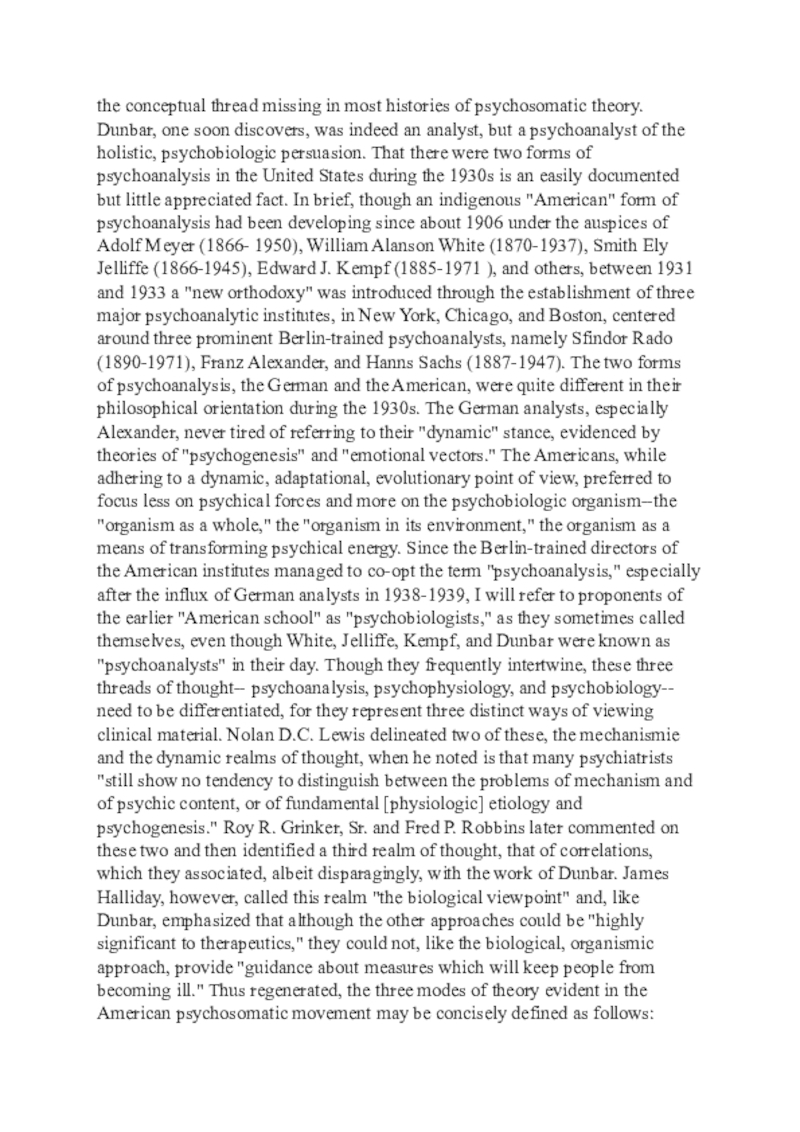
Слайд 6during the 1930s the dynamic mode, primarily psychoanalytic, emphasized psychical
forces, etiology, specificity, and a focus on the past, e.g.,
psychogenesis; the mechanismic mode, for the most part psychophysiologic, emphasized organic processes, pathologic lesions, and a puzzle-solving concern with the present, e.g., the maintenance of homeostasis; the organismic, correlational mode, predominantly psychobiologic and akin to a general medical orientation, emphasized functions, meanings, and wholes--such as character and constitution--plus a focus on the future, e.g., purpose, prognosis, and prevention. It might not be too simplistic to say that the first focused on the mind, the second on the body, and the third on the patient as a whole. Although Dunbar's holistic way of thinking significantly differed from that of many psychoanalysts and psychophysiologists, her organismic viewpoint built upon the other two views, and can best be understood through contrast. In the present limited study I shall only touch upon the dynamic mode of theory, skipping the mechanismic mode entirely, before considering Dunbar's organismic approach. Though one can hardly imagine a more extreme contrast to Dunbar's way of thought than Alexander's, one must take some pains to characterize his work, for he is generally considered the foremost psychosomatic theorist of the 1930s and 1940s, and he was Dunbar's principal critic. During the 1920s and 1930s, when many analysts tended to repudiate Sigmund Freud's earliest conceptions, they at the same time tended to conceptualize his nascent ego psychology in
out-moded, force-oriented terms. Alexander, for example, building upon Freud's
newly announced notions of the "death instinct," and upon Sfindor Ferenczi's (i873- 1933) notions of the erotization of diseased organs described the "essential disease process" in both organic and psychical illness as "a turning back upon the self of the outwardly directed death instinct," and regarded "the conscious phenomena of symptom formation" as "manifestations of Eros." Without going into further detail, it can be said that Alexander faithfully followed Freud, but that he overrationalized and schematized his master's work. What began under Ferenczi and Freud as probing attempts to conceptualize the variety of clinical experience became, under Alexander, standardized schemata applicable to all symptoms and pathologic states. Similarly, when Alexander founded the Chicago Institute for Psychoanalysis in 1932, he made his guiding research principle the hypothesis that the "psychic causative factors of somatic disturbance are of a specific nature," and he set out to establish "the affinity of specific emotional factors with....specific vegetative systems" and "certain kinds of specific organic expression." The theoretical basis for this research developed along the lines of what Alexander called er "the logic of emotions." Depriving "emotional syltogisms"--such as "I hate him because he attacks me"--of their ideational content, and restricting attention to "the dynamic quality (direction)
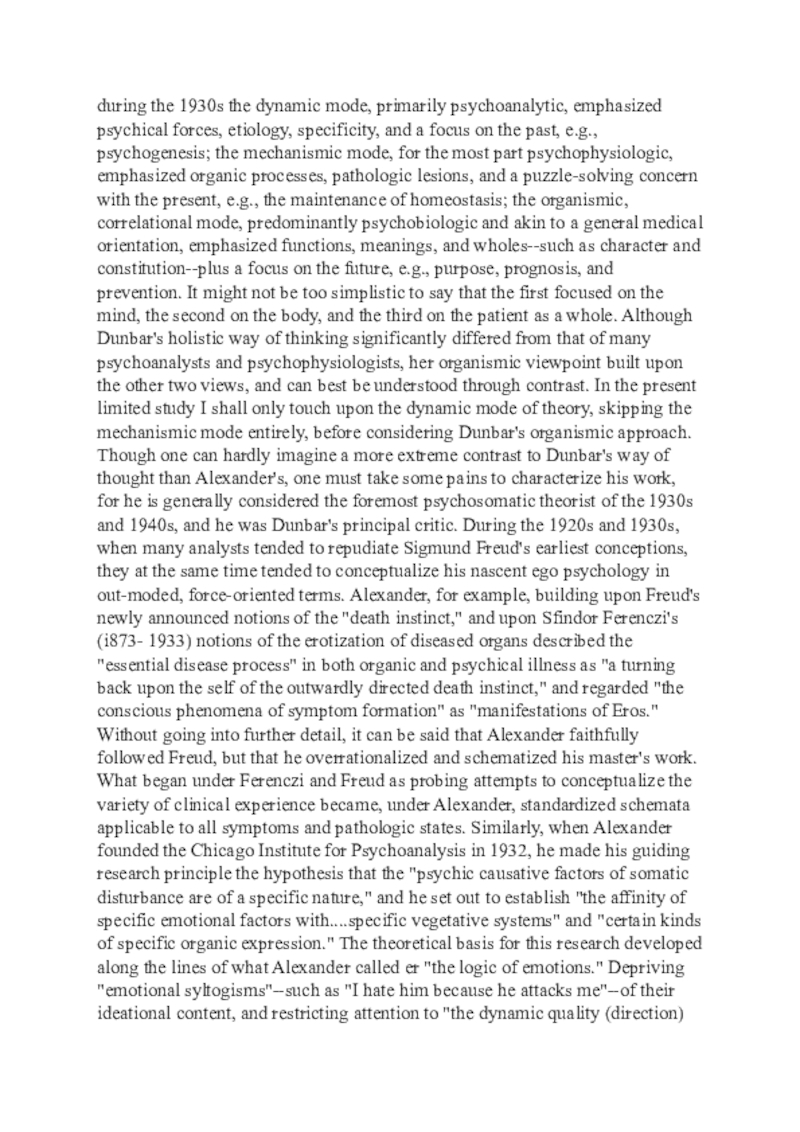
Слайд 7of their tendencies," Alexander derived three "simple dynamic relations" he
called the "vectors" of emotion. Having differentiated three degrees of
conflict, and having found "instinctual conflict" based on "the incompatibility of coexistent opposed striving's" to be the most devastating of the three, Alexander chose to concentrate on these "strivings," i.e., the "dynamic directional tendencies," the "vectors" of emotion.
Alexander's vocabulary, such "strivings," "tendencies," or "vectors," and his constant reiteration of the phrase "dynamic psychiatry" made it appear that his was a truly dynamic theory. However, just as his earlier general theory of disease reduced all clinical phenomena to one simple scheme--Eros versus the death instinct--his vector theory of emotion reduced all manifestations of conflict to one static, predetermined program, that is, infantile dependence leading to feelings of inferiority, leading to narcissistic protest, leading to overcompensation, etc. For example, 29 "If the wish to be loved by a protecting woman according to the infantile pattern is excluded from consciousness because it hurts the self-esteem of the personality, it mobilizes the emotionally associated wish to be fed." Somehow these sentiments lack Freud and Ferenczi's insight and sense of relevance. However, it was not to matter that Alexander reduced psychoanalysis to a simplistic dialectical psychology, or that he ignored physiology in the formulation of his psychosomatic theories. 3° Ferenczi, his conceptual mentor and a favorite among the Americans, fell from Freud's favor in 1932,31-33 while Wilhelm Reich (1897-1957), Alexander's chief conceptual adversary,34, a5 came under Freud's decisive censure in 1934. 3~' 37 Dunbar, whose early ties lay with both Ferenczi and Reich and who suffered by their downfall, could not have cared less about Alexander's emphasis on specificity, and devoted her energies to developing the organismic trends of American psychiatry. Thus unopposed, Alexander, the director of a most active and well- funded psychoanalytic institute, rose as a decidedly effective critic of Dunbar's writings. 38 Unfortunately, Alexander seemed unable to conceive of a psychosomatic medicine unconcerned with either etiology or specificity, and it was he who attributed 39-41 the "specificity of personality" theory to Dunbar.
The two appeared to be friends, but Alexander consistently misunderstood her
theories and effectively propagated his misunderstandings. Thus Dunbar's Emotions and Bodily Changes is frequently noted by modern authors and then quickly dismissed, in words recalling Alexander. The essence of Alexander's critique, however, that Dunbar's research did not use psychoanalysis and that her formulations were not truly dynamic, specific, or etiologic, must be seen as totally irrelevant to what Dunbar was trying to accomplish. As Dunbar reiterated in a book 4a published on the day of her death, "The goal is not so
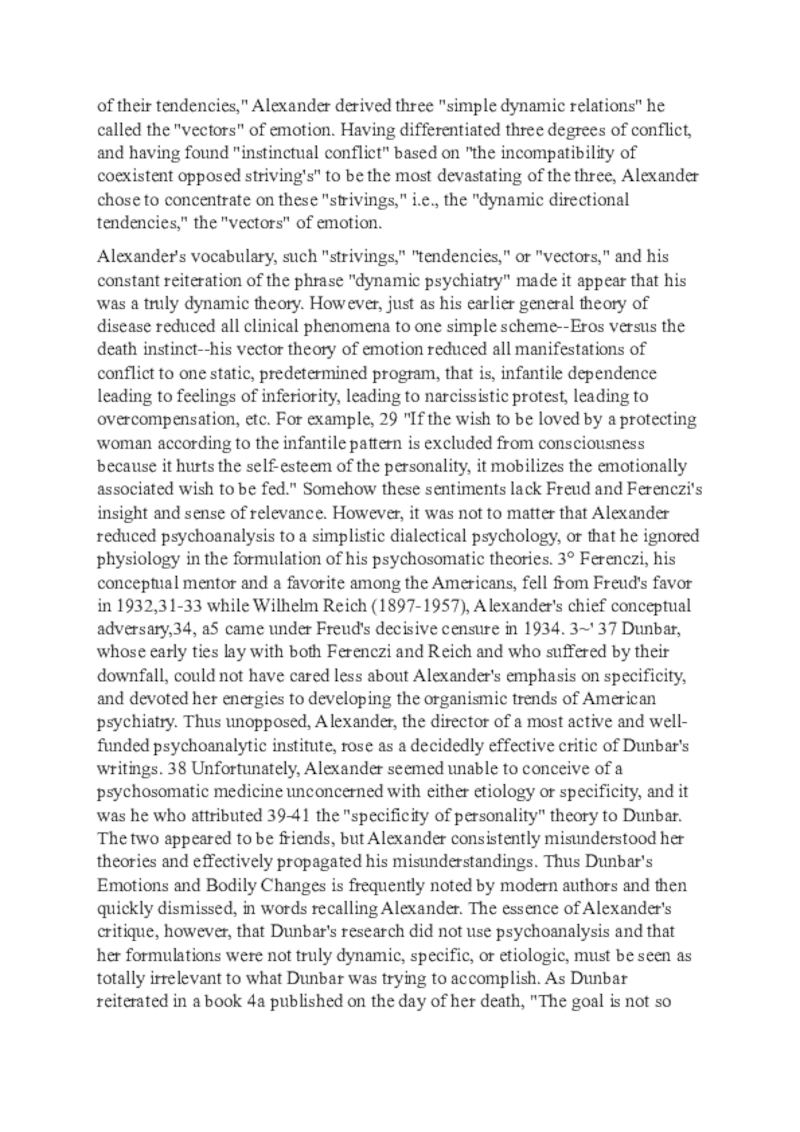
Слайд 8much to find or manipulate a 'cause' as to discover
a means of effective intervention. This is, after all, what
concerns the physician more than historical explanation of causes which may be irrelevant to the change desired." The marked contrast between Alexander and Dunbar's ways of thinking became apparent as early as 1934. That year there occurred two symposia on psychosomatic problems, one organized by Alexander at the meeting of the American Psychoanalytic Association, and another held before the American Psychiatric Association by Dunbar and her colleagues. At the psychoanalytic meeting, Karl Menninger advised 44 that a sharp distinction should be drawn between "etiological research" and "therapeutic research." Having commended Alexander's group for their etiologic studies relating early gastric experience to subsequent gastric disease, Menninger went on 44 to remind the audience that patients are not cured because certain repressed material is retrieved from the past and communicated, but because of the "emotional reorientation" in which the patient may be therapeutically guided to face the future, an opinion with which Dunbar would have concurred. During the 1930s, Alexander's group in Chicago pursued a dynamicity oriented, predominantly etiological approach to psychosomatic research, based on selected patients seen in analysis. In contrast, work by Dunbar and her colleagues in New York demonstrated a correlational, organismic, distinctly therapeutic and preventive approach, based on hundreds of cases seen on the public medical wards and outpatient medical clinics--which brings us to another point. Although most discussions of psychosomatic medicine emphasize its origins in psychoanalysis and psychopbysiology--the dynamic and mechanismic modes of thought--few if any mention the area in which psychosomatic medicine truly took roots and grew, namely in psychobiology, the correlational, organismic mode of thought focusing on the patient as a whole in his environment. The answer to the question, why this approach has received so little emphasis in present-day psychiatry, is in one sense simple: Psychosomatic medicine and the way of thought involved, despite the prefix "psycho-," was never a true branch of psychiatry. Though nursed by some outstanding psychiatrists--in fact, the leaders in their field--the organismic approach developed primarily within the realm of general medicine. At the peak of the American psychosomatic movement of the 1930s and 1940s, for example, the interest and research money of organized psychiatry were directed toward research on epilepsy and schizophrenia, not toward research on psychosomatic disorder. 45, 46 Furthermore, if one considers those psychiatrists who propagated the American psychosomatic movement, one finds individuals of a general medical orientation, such as Adolf Meyer, William A. White, and Dunbar, whose work focused more on effective therapeutic intervention than on psychophysiologic mechanisms or on supposed psychoetiologic factors in
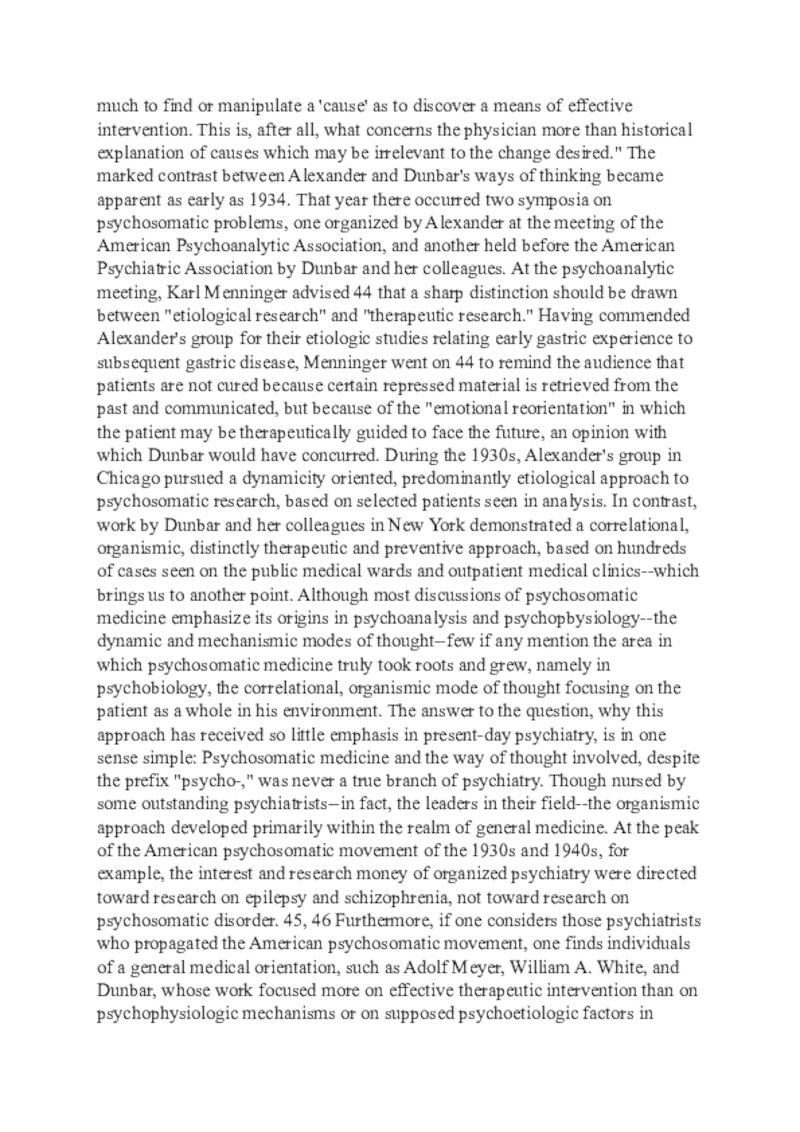
Слайд 9disease. In fact, psychosomatic medicine has been defined by one
prominent psychiatrist, 4r as "the psychobiologic approach of Adotf Meyer,
not to the psychoses and not to mental diseases, but to the disorders lying within the domain of general medicine." This comment aptly conveys that Meyer, despite his prestigious role as director of the Phipps Psychiatric Clinic in Baltimore, exercised perhaps greater influence outside of psychiatry than within. White, too, though superintendant of the sprawling Government Hospital for the Insane in Washington DC, habitually drew from and contributed to areas outside the bounds of traditional psychiatry. Perhaps even more effectively than Meyer, White stressed 48-5° the relevance of organismic, symbolistic conceptions borrowed from biology and Gestalt psychology. Then there was Dunbar. During most of her years at Columbia she worked as a psychiatrist "on assignment to the Department of Medicine," where her nonmedical background in religious education and healing (which is another long story) helped ease psychoanalysis- hitherto so heavily associated with sex--into the public medical wards of Columbia Presbyterian Hospital.
In summary
The dynamic, mechanismic, and organismic modes of thought in psychosomatic medicine each had their origin in the late nineteenth century, and each contributed to the American psychosomatic movement of the 1930s. Alexander founded the first psychoanalytic institute devoted to psychosomatic research in 1932, the same year Walter B. Cannon (1871-1945) amplified the concept "homeostasis," and the same year Dunbar began her major studies at Columbia. Two years later interest warranted two symposia, and by 1935 the movement had definitely begun to gain impetus. Alexander developed his vector theory in "The logic of emotions," Wittkower's comprehensive "Studies on the influence of emotions" appeared, and Dunbar published her organismic survey, Emotions and Bodily Changes. In the mid to late 1930s, psychoanalysis gained hold of American psychiatry with an influx of European analysts, while psychophysiology also gained stature with the increased sophistication of instruments and methods. Psychobiology, however, faced 1935 with the disrepute of two possible leaders, Ferenczi and Reich, plus the virtual retirement of four others, Meyer, White, Jelliffe, and Draper--none of whose students effectively spread their word. Only Dunbar appeared to fill the vacuum, and her medical career began at an unauspicious time, during the ascendancy of both analysis and physiology, so that her work emerged in the face of prevailing conceptual biases. That is, a holistic, organismic approach that was readily
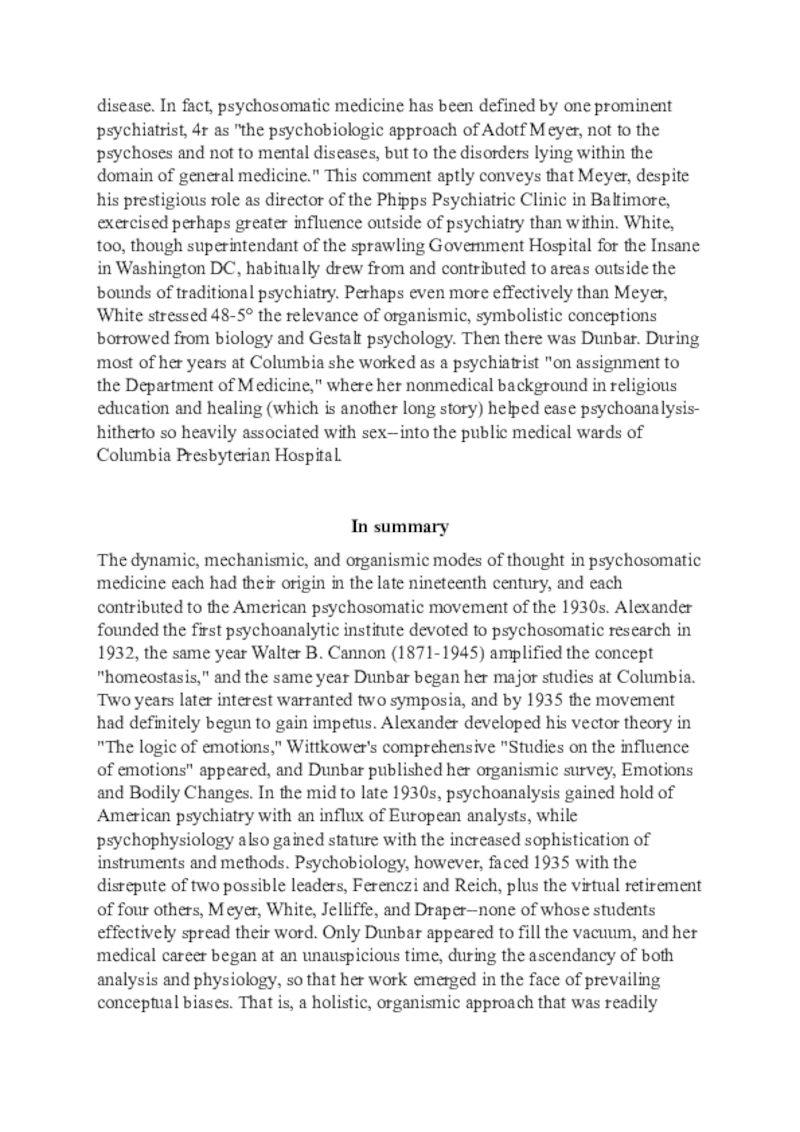
Слайд 10accepted in 1925, or even the 1930s, would not have
been able to command attention after 1940, when the dynamic
and mechanismic modes of thought were to have their day. In terms of the medical context, Dunbar appeared on the scene too late. But her fate--a rapid rise, due to her brillance, followed by a rapid fall, due to her content~was not to be avoided, for Dunbar's nonmedical views on "healing and wholeness" determined her career. Despite Dunbar's medical role, one must look to her nonmedical background to grasp the full meaning of her work.